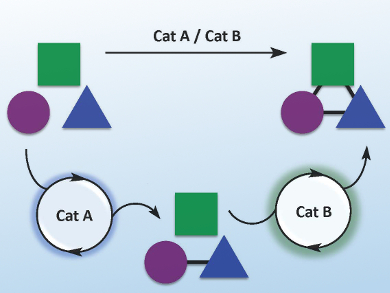Multicomponent and multicatalytic reactions represent one of the newest trends in catalysis. This concept emerged as an attempt to mimic the efficiency of biological systems in producing complex molecules from a series of different starting materials by the action of several enzymes.
In the artificial version, a set of simple compounds and various catalysts are mixed in a single pot to generate a new molecule in a specific way. Incompatibility problems between reagents and/or catalysts, along with the multiple reaction pathways associated with the reactions, may have prevented an earlier development of this concept.
Félix Rodríguez, Francisco J. Fañanás, and Alicia Galván, University of Oviedo, Spain, present an overview of some of the most representative examples of multicomponent and multicatalytic reactions. The highlighted examples include a remarkable multicomponent synthesis of amines reported by Matthias Beller and colleagues that constitutes one of the first examples of multicomponent and multicatalytic reactions [1]. In this process, two different metallic complexes derived from rhodium and iridium share a unique phosphine ligand to independently promote a hydroformylation and a reductive amination, respectively.
Apart from catalytic systems formed by two metals, other metal/organocatalyst and organocatalyst/organocatalyst binary systems have also been employed. For example, Darren J. Dixon and colleagues reported an asymmetric synthesis of functionalized cyclohexane derivatives trough a multicomponent reaction catalyzed by two different organocatalysts (a chinchona-based thiourea and a proline-based secondary amine) [2].
However, the concept of multicomponent and multicatalytic reactions is still in its infancy and new results are expected in the near future. Particularly, the development of reactions with more than three reagents and/or more than two catalysts seems an interesting research area.
- Multicomponent and Multicatalytic Reactions – A Synthetic Strategy Inspired by Nature,
Alicia Galván, Francisco J. Fañanás, Félix Rodríguez,
Eur. J. Inorg. Chem. 2016.
DOI: 10.1002/ejic.201501287
References
- [1] The First Efficient Hydroaminomethylation with Ammonia: With Dual Metal Catalysts and Two-Phase Catalysis to Primary Amines,
Burkhard Zimmermann, Jürgen Herwig, Matthias Beller,
Angew. Chem. Int. Ed. 1999, 38, 2372–2375.
DOI: 10.1002/(SICI)1521-3773(19990816)38:16<2372::AID-ANIE2372>3.0.CO;2-H - [2] Asymmetric Organocatalytic Relay Cascades: Catalyst-Controlled Stereoisomer Selection in the Synthesis of Functionalized Cyclohexanes,
Yao Wang, Rong-Gang Han, Yong-Long Zhao, Shu Yang, Peng-Fei Xu, Darren J. Dixon,
Angew. Chem. Int. Ed. 2009, 48, 9834–9838.
DOI: 10.1002/anie.200905014




